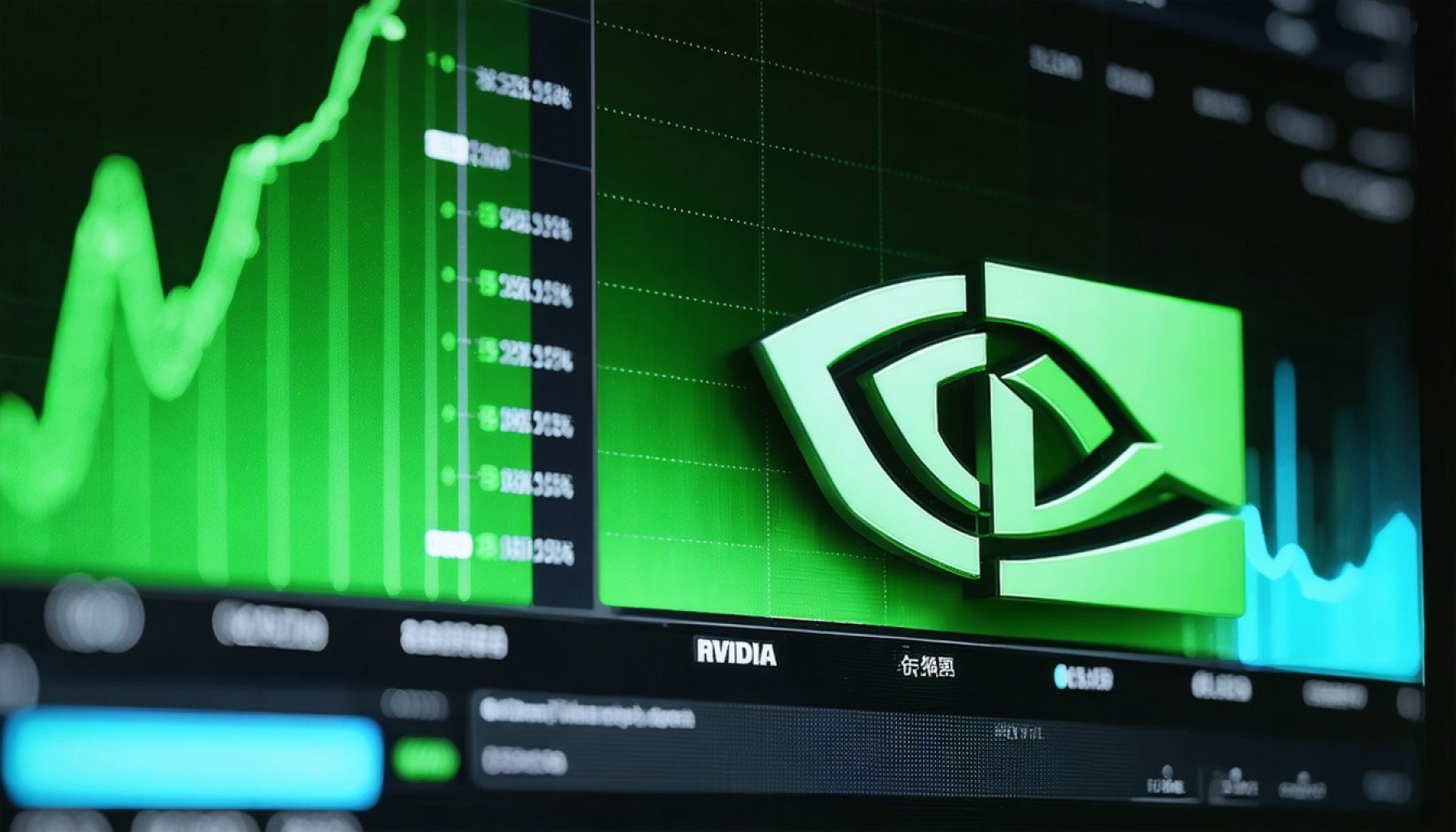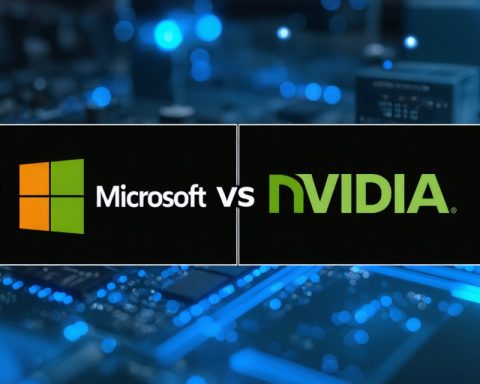- NVIDIA’s market cap exceeds $3 trillion, highlighting its dominance in the semiconductor industry.
- Post-earnings, NVIDIA’s stock trends upward about 55% of the time, recently reaching 58%, intriguing event-driven traders.
- Past instances have seen post-earnings stock price jumps of over 20% in a single day, with a median rise of 4.9% on positive days.
- Traders analyze correlations between short-term (1D) and medium-term (5D) post-earnings returns to uncover predictive patterns.
- Peer performance and market sentiment prior to NVIDIA’s announcements shape expectations and influence strategic trading decisions.
- Understanding NVIDIA’s historical post-earnings trends offers potential strategic advantages in navigating market uncertainties.
Amid the buzzing anticipation of NVIDIA’s upcoming earnings announcement, investors brace themselves for the post-release stock dance. With a market cap soaring past $3 trillion, this semiconductor titan has proven its power. Yet, the real intrigue lies in its past post-earnings performance—a rich tapestry of market maneuvers that some savvy traders aim to decode for future gains.
Imagine a roulette wheel where the odds slightly favor the bold. NVIDIA’s post-earnings one-day successes occur approximately 55% of the time over the last five years, nudging to 58% recently. This nuanced balance fascinates event-driven traders who craft their moves with surgical precision. The stock has, in moments of exuberance, vaulted over 20% in a single trading day following earnings. The thrill doesn’t rest here—a typical positive day sees a median hop of 4.9%.
For those daring to predict the tides, understanding NVIDIA’s historical earnings reactions might be the anchor. Traders cleverly map correlations between short-term (1D) and medium-term (5D) returns, hunting for patterns like starry-eyed astrologers deciphering celestial movements. A positive correlation suggests that a single day of post-earnings glow often still flickers across five days. Such insights drive strategic plays, positioning confidently for the days ahead if a one-day bump is promising.
Greater still is the interconnected dance with peers, where the company’s fate can subtly echo the market’s response to its tech compatriots. Before NVIDIA even speaks, whispers from its rivals color market expectations, crafting a backdrop of anticipation and caution.
Takeaway: As NVIDIA paints its fiscal landscape, seasoned traders eye historical patterns akin to surfers evaluating waves, searching for the perfect surge to ride. Though uncertainty remains, mastering these historical echoes can guide confident strides in a tempestuous market sea.
Unlocking NVIDIA’s Earnings Performance: Insider Secrets and Investor Insights
How-To Steps & Life Hacks
If you are looking to master NVIDIA’s earnings patterns, here’s how to get started:
1. Historical Analysis: Begin by reviewing past earnings reports and stock movements. The key statistic – a 58% likelihood of positive post-earnings performance recently – suggests a slightly better-than-even chance of a stock rise.
2. Short-term Trading: For day trading right after earnings, look for patterns in the opening and closing prices. A positive day usually averages a 4.9% gain, with potential spikes sharply upwards from there.
3. Peer Review: Analyze the performance and forecasting of NVIDIA’s main competitors, such as AMD. The market often reacts to NVIDIA based on these comparisons.
Real-World Use Cases
– Investment Strategy: Long-term investors should focus on NVIDIA’s historical growth trends and technological innovations, like its advancements in AI and data center solutions.
– Portfolio Diversification: Given the volatile nature of tech stocks, place NVIDIA within a diversified portfolio to balance risk.
Market Forecasts & Industry Trends
– Industry Growth: The semiconductor industry is expected to grow at a CAGR of 8-10% over the next five years, fueled by advancements in AI, 5G, and automotive technology. (Source: Semiconductor Industry Association)
– Emerging Markets: NVIDIA is poised to leverage new opportunities, such as AI processors and cloud computing, which are burgeoning sectors in the tech industry.
Reviews & Comparisons
– Performance vs. Peers: NVIDIA remains a leader in the GPU market, outperforming rivals like AMD and Intel in terms of innovation and market share.
– Consumer Feedback: Users appreciate NVIDIA’s high-performance graphics cards, but they note the premium pricing.
Controversies & Limitations
– Supply Chain Issues: During the global semiconductor shortage, NVIDIA faced significant challenges, although their strategic partnerships have partially cushioned the impact.
– Regulatory Scrutiny: As a tech giant, NVIDIA must navigate strict regulations, particularly in data privacy and international trade.
Features, Specs & Pricing
– Products: NVIDIA dominates with RTX graphics cards known for ray tracing technology, utilized heavily in gaming and professional visualization.
– Pricing Strategy: Although competitive, NVIDIA’s pricing reflects its cutting-edge tech. Expect to pay a premium, especially at product launches or during shortages.
Security & Sustainability
– Cybersecurity Measures: NVIDIA invests heavily in ensuring the security of data processed by its GPUs, crucially important as cloud and AI computing expand.
– Sustainability Initiatives: The company is committed to reducing its carbon footprint with sustainable technology and practices.
Insights & Predictions
– Stock Performance: With a strong hold on emerging technologies, NVIDIA’s growth trajectory remains positive. Analysts anticipate continued stock appreciation barring significant disruptions.
– Tech Innovations: NVIDIA is expected to continue pioneering AI and deep learning technologies, maintaining its leadership in the GPU market.
Tutorials & Compatibility
– Product Compatibility: NVIDIA products work best with the latest software updates. Ensure your drivers are up to date through the NVIDIA website.
Pros & Cons Overview
Pros:
– Leader in GPU technology
– Strong stock performance and market capitalization
– Innovative and forward-thinking in AI and other tech areas
Cons:
– Premium pricing
– Sensitive to supply chain issues and international regulations
Conclusion
To ride NVIDIA’s wave, focus on understanding historical stock patterns and maintain a diversified investment approach. Keep abreast of industry trends and NVIDIA’s competitors for well-rounded insights.
Quick Tips:
– Use dedicated apps or platforms for real-time stock analysis.
– Consider both short-term trades around earnings and long-term investments for sustained growth.
– Keep tabs on global tech trends affecting NVIDIA, such as the AI boom and chip shortages.
For more on NVIDIA and tech innovations, visit nvidia.com.











